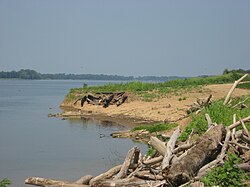Yankeetown site
Yankeetown archeological site | |
 Eastern portion of the site | |
| Location | Along the Ohio River bank in Section 21 of Anderson Township, south ofYankeetown,Indiana[2]: 13 |
|---|---|
| Coordinates | 37°54′1″N87°18′22″W/ 37.90028°N 87.30611°W |
| Area | 140 acres (57 ha) |
| NRHP referenceNo. | 79000026[1] |
| Added to NRHP | February 28, 1979 |
TheYankeetown site(12W1[2]: 12 ) is a substantialarchaeological sitealong theOhio Riverin the southwestern part of theU.S. stateofIndiana.Inhabited during the prehistoricWoodland period,the site has yielded important information about Woodland-era peoples in the region, but it has been damaged by substantial erosion. Despite the damage, it has been ahistoric sitefor more than thirty years.
Geology
[edit]Yankeetown lies primarily inSection21 ofAnderson TownshipinWarrick County.Because of the presence of the Ohio River, this section is a tiny riverside triangle, unlike the mile-square sections to the east and north. The present-dayunincorporated communityofYankeetownlies approximately 1.5 miles (2.4 km) north of the site;[2]: 13 a road runs from the town to the riverside, and the road/river junction marks one end of the site's core section. This section extends along the riverbank for about 0.75 miles (1.21 km) downstream from the road,[2]: 12 The riverbank core of the site has experienced extensive damage fromerosionby the river: in 1950, landowners along the river stated that approximately 20 feet (6.1 m) of the bank were cut away annually.[2]: 13
Excavations
[edit]Glenn Albert Blackvisited Yankeetown in April 1950 with three companions; the four surveyed the site carefully and began catalogingartifactsfound there. Heavy erosion permitted them to identifyfeaturessuch as pits and hearths, and artifacts such as clay pellets and bits of charcoal and burned clay were numerous.[2]: 12 Four months later, a second survey investigated the site. Among its premier findings was the identification of a layer ofdaubabout 8 inches (200 mm) below the surface at the site's low end; although it was only 10 feet (3.0 m) long, the layer was significant for its composition of burned debris, grass, and weeds, as well as for its place as the location of a depression that could have been the site of a house.[2]: 13
Specific artifacts
[edit]Many artifacts found at Yankeetown are curated in the museum atAngel Mounds State Memorialin nearbyEvansville,[2]: 13 although the second 1950 survey kept its findings separate from those at Angel, and the landowner maintained a substantial collection.[2]: 15 More than six thousandsherdsfrom Yankeetown are curated at Angel; the majority of those known in 1950 weretemperedwith clay and/or grit, although six hundred bore evidence of shell tempering, and only about five hundred lacked evidence of a tempering agent. Meanwhile, large numbers of the sherds are plain; hundreds have been found marked with cords or incisions, but approximately 64% of the pottery known in 1950 was completely undecorated.[2]: 14 Rarer items found at Yankeetown include flint knives,hammerstones,trowels,lithic flakes,bones, objects ofcannel coal,and two damagedpottery effigiesof women with everything below the shoulders broken off.[2]: 15
Conclusions
[edit]The second 1950 survey named Yankeetown thetype sitefor a variety of pottery that had been subjected both toappliquéand toincision;when found elsewhere, it was called "Yankeetown fillet" or "Yankeetown incised".[2]: 14
Yankeetown-like objects have been found far away from Yankeetown; they are known farther north thanVincennes, Indianaon the Wabash, at theGreat Salt SpringinGallatin County, Illinois,[3]: 165 and in the Illinois side of theSt. Louis metropolitan area.[4]It appears to be related to another Late Woodland manifestation known as theDuffy complex,[3]: 162 which is known from a small group of sites near the mouth of the Wabash;[5]both Yankeetown and Duffy have been found at the Great Salt Spring,[3]: 165 but the precise relationship between the two is unclear.[3]: 162
Preservation
[edit]Preservation of the Yankeetown site has been difficult, due to erosion by the river, although the curation of artifacts at the Angel museum has assisted in saving information about the site.[2]: 13 In order to facilitate further preservation work, the site was listed on theNational Register of Historic Placesin 1979. It is one of eight National Register-listed locations inWarrick County;other county sites with this designation include a portion of the Angel Mounds State Memorial and a nearbyCaborn-WelbornMississippian site, theEllerbusch site.[1]
See also
[edit]References
[edit]- ^ab"National Register Information System".National Register of Historic Places.National Park Service.July 9, 2010.
- ^abcdefghijklmCurry, Hilda J.Archaeological Notes on Warrick County Indiana.Indianapolis:Indiana Historical Bureau, 1954.
- ^abcdMuller, Jon.Archaeology of the Lower Ohio River Valley.Walnut Creek:Left Coast, 2009.
- ^Alt, Susan M. "Identities, Traditions, and Diversity in Cahokia's Uplands".Midcontinental Journal of Archaeology27.2 (2002): 217-235: 223.
- ^Winters, Howard D.An Archaeological Survey of the Wabash Valley in Illinois.Springfield:Illinois State Museum Society, 1963, 82-83.
- 1950 archaeological discoveries
- Archaeological type sites
- Archaeological sites on the National Register of Historic Places in Indiana
- Coastal erosion in the United States
- Geography of Warrick County, Indiana
- Middle Mississippian culture
- Ohio River
- Woodland period
- National Register of Historic Places in Warrick County, Indiana



